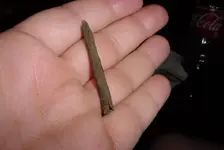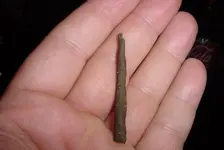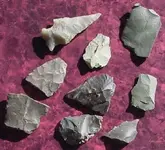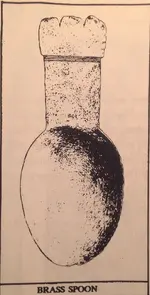You are using an out of date browser. It may not display this or other websites correctly.
You should upgrade or use an alternative browser.
You should upgrade or use an alternative browser.
THOUGHTS...
- Thread starter CASPER-2
- Start date
TheRingFinder
Bronze Member
Casper - I found a copper trading knife with the same "hammered" look. I talked with some historians about it's date and origin:
I was told - All metal objects such as copper found within Indian sites, were "trading" items. The settlers would trade metal utensils for furs, meat etc.
Circa - mid 1800's.............The Indian's had no means of creating metal objects.
I was told - All metal objects such as copper found within Indian sites, were "trading" items. The settlers would trade metal utensils for furs, meat etc.
Circa - mid 1800's.............The Indian's had no means of creating metal objects.
Charl
Silver Member
- Joined
- Jan 19, 2012
- Messages
- 3,076
- Reaction score
- 4,773
- Golden Thread
- 0
- Location
- Rhode Island
- Primary Interest:
- Relic Hunting
I guess the question is whether it's European or Native made. It's similar enough to Fowler's illustration in Hoffman's New England artifact guide, that I'm inclined to think it Native made from sheet brass. I think the head is European made. For the rolled copper to still have wood in it amazes me, given New England's acidic soil, though less so in Ct. Valley. That is cool. And so is the spoon....
See "Metal Cutouts of the Northeast" for an example of a native made spoon.....
http://library.bridgew.edu/exhibits/BMAS/pdf/MAS-v34n0304.pdf
See "Metal Cutouts of the Northeast" for an example of a native made spoon.....
http://library.bridgew.edu/exhibits/BMAS/pdf/MAS-v34n0304.pdf
Last edited:
CASPER-2
Platinum Member
- Joined
- Jan 3, 2012
- Messages
- 17,206
- Reaction score
- 20,171
- Golden Thread
- 1
- Location
- NEW ENGLAND
- 🥇 Banner finds
- 1
- 🏆 Honorable Mentions:
- 6
- Detector(s) used
- WHITE'S XLT, PI PRO, GARRETT 2500, 3- FISHER CZ21s, JW FISHER 8X
- Primary Interest:
- All Treasure Hunting
- #5
Thread Owner
actually - archaeologists mentioned in a paper they wrote on an area about 10 miles north of my site - that they excavated an indian village - pre 1750s - they found a copper spoon along with stone hand tools and other artifacts - have not seen pic of one they found - but mine is definitely not a trade item its thin and crude and you can tell bowl was hammered by a rock most likely - could it have been made by a bored early colonists probably - but it looks like someone tried copying something they saw - I found my complete trefid spoon bout 1/2 mile away along with many handle and bowl parts of trefids and seal top spoons
Casper - I found a copper trading knife with the same "hammered" look. I talked with some historians about it's date and origin:
I was told - All metal objects such as copper found within Indian sites, were "trading" items. The settlers would trade metal utensils for furs, meat etc.
Circa - mid 1800's.............The Indian's had no means of creating metal objects.
Charl
Silver Member
- Joined
- Jan 19, 2012
- Messages
- 3,076
- Reaction score
- 4,773
- Golden Thread
- 0
- Location
- Rhode Island
- Primary Interest:
- Relic Hunting
actually - archaeologists mentioned in a paper they wrote on an area about 10 miles north of my site - that they excavated an indian village - pre 1750s - they found a copper spoon along with stone hand tools and other artifacts - have not seen pic of one they found - but mine is definitely not a trade item its thin and crude and you can tell bowl was hammered by a rock most likely - could it have been made by a bored early colonists probably - but it looks like someone tried copying something they saw - I found my complete trefid spoon bout 1/2 mile away along with many handle and bowl parts of trefids and seal top spoons
In Handbook of Native American Artifacts from Southern New England, Curtiss Hoffman lists "Brass Spoons" as a distinct, separate class of native made metal cutouts. And I think the example I linked to demonstrates a similarity to the one you found. Here is Hoffman's entry, referring to the one in the illustration I linked to:
"...this well fashioned spoon stands out as an unusual example of fine hand work. It appeared in a burial with a small Late Woodland pot at Wapanucket #1 in Middleboro. Its slightly roughened thin edges and irregular design suggest that it was handmade from a piece of sheet brass. The metal resembles that from colonial brass kettles, which probably was its source...it illustrates the existence of superior manual skill among some natives of colonial times"
As noted in an earlier comment, I lean toward your spoon being native made as well. As cool a find as it gets, IMHO. Thinness might not be a qualifying condition, as colonial,spoons could be pretty thin, but I still think that's a native made example from sheet brass.
Here's that spoon, native made, IMO compares favorably to your spoon.....
Attachments
Last edited:
CASPER-2
Platinum Member
- Joined
- Jan 3, 2012
- Messages
- 17,206
- Reaction score
- 20,171
- Golden Thread
- 1
- Location
- NEW ENGLAND
- 🥇 Banner finds
- 1
- 🏆 Honorable Mentions:
- 6
- Detector(s) used
- WHITE'S XLT, PI PRO, GARRETT 2500, 3- FISHER CZ21s, JW FISHER 8X
- Primary Interest:
- All Treasure Hunting
- #7
Thread Owner
that's cool = thanks - looks like they tried to copy trefid design

In Handbook of Native American Artifacts from Southern New England, Curtiss Hoffman lists "Brass Spoons" as a distinct, separate class of native made metal cutouts. And I think the example I linked to demonstrates a similarity to the one you found. Here is Hoffman's entry, referring to the one in the illustration I linked to:
"...this well fashioned spoon stands out as an unusual example of fine hand work. It appeared in a burial with a small Late Woodland pot at Wapanucket #1 in Middleboro. Its slightly roughened thin edges and irregular design suggest that it was handmade from a piece of sheet brass. The metal resembles that from colonial brass kettles, which probably was its source...it illustrates the existence of superior manual skill among some natives of colonial times"
As noted in an earlier comment, I lean toward your spoon being native made as well. As cool a find as it gets, IMHO. Thinness might not be a qualifying condition, as colonial,spoons could be pretty thin, but I still think that's a native made example from sheet brass.
Here's that spoon, native made, IMO compares favorably to your spoon.....
CASPER-2
Platinum Member
- Joined
- Jan 3, 2012
- Messages
- 17,206
- Reaction score
- 20,171
- Golden Thread
- 1
- Location
- NEW ENGLAND
- 🥇 Banner finds
- 1
- 🏆 Honorable Mentions:
- 6
- Detector(s) used
- WHITE'S XLT, PI PRO, GARRETT 2500, 3- FISHER CZ21s, JW FISHER 8X
- Primary Interest:
- All Treasure Hunting
- #8
Thread Owner
Here is another copper or bronze point/awl??
- this was found at an actual winter camp site used by King Phillips braves in Ma.
I don't think this camp has been excavated for non-metallic objects -but has been peppered by detectorists
this is the only thing found that day by myself and others - it was found in a shallow trench line that I think was made for tent drain
and probably why it was missed


- this was found at an actual winter camp site used by King Phillips braves in Ma.
I don't think this camp has been excavated for non-metallic objects -but has been peppered by detectorists
this is the only thing found that day by myself and others - it was found in a shallow trench line that I think was made for tent drain
and probably why it was missed


CASPER-2
Platinum Member
- Joined
- Jan 3, 2012
- Messages
- 17,206
- Reaction score
- 20,171
- Golden Thread
- 1
- Location
- NEW ENGLAND
- 🥇 Banner finds
- 1
- 🏆 Honorable Mentions:
- 6
- Detector(s) used
- WHITE'S XLT, PI PRO, GARRETT 2500, 3- FISHER CZ21s, JW FISHER 8X
- Primary Interest:
- All Treasure Hunting
- #9
Thread Owner
don't know where they went to school
copperculture
just one of tons of resources on Indians using copper - though not my area (new England)- its out there
copperculture
just one of tons of resources on Indians using copper - though not my area (new England)- its out there
Casper - I found a copper trading knife with the same "hammered" look. I talked with some historians about it's date and origin:
I was told - All metal objects such as copper found within Indian sites, were "trading" items. The settlers would trade metal utensils for furs, meat etc.
Circa - mid 1800's.............The Indian's had no means of creating metal objects.
Last edited:
Charl
Silver Member
- Joined
- Jan 19, 2012
- Messages
- 3,076
- Reaction score
- 4,773
- Golden Thread
- 0
- Location
- Rhode Island
- Primary Interest:
- Relic Hunting
I found one of those "trefid" design spoons. Did not know they were quite that old. As far as the Old Copper Culture, they began utilizing what is known as "native copper", in their case from the Great Lakes, some 7000 years ago. Yes, the conical copper points from the Old Copper Culture and copper conical points made by natives in the Contact Era are similar in design. But, with a little bit of wood preserved in your point, CASPER-2, which I still find amazing, definitely makes that one 17th-18th century, and not OCC. No way does the wood last 4000+ years in Ma.!! In other words, they only look similar. Your's is 17th-18th century, as well as being far outside the normal range of OCC artifacts. As far as natives "having no means of making metal objects", I suspect the archaeologists who said that were saying they did not smelt copper on their own. Some think there is evidence that the OCC smelted copper, but few buy that. It was cold hammered. And yes, many metal items could just be traded straight, or, as was so common, brass and copper kettles were cut up to make various weapons and tools. So the natives made things with metal, but they were not metallurgists, and that's probably what was meant by "no means of making(smelting) metal"........
Last edited:
CASPER-2
Platinum Member
- Joined
- Jan 3, 2012
- Messages
- 17,206
- Reaction score
- 20,171
- Golden Thread
- 1
- Location
- NEW ENGLAND
- 🥇 Banner finds
- 1
- 🏆 Honorable Mentions:
- 6
- Detector(s) used
- WHITE'S XLT, PI PRO, GARRETT 2500, 3- FISHER CZ21s, JW FISHER 8X
- Primary Interest:
- All Treasure Hunting
- #12
Thread Owner
oh not saying mine are that old - I know better - just try to prove that Indians did work with copper
if they did it 1000s of yrs ago - why not 100s
if they did it 1000s of yrs ago - why not 100s
I found one of those "trefid" design spoons. Did not know they were quite that old. As far as the Old Copper Culture, they began utilizing what is known as "native copper", in their case from the Great Lakes, some 7000 years ago. Yes, the conical copper points from the Old Copper Culture and copper conical points made by natives in the Contact Era are similar in design. But, with a little bit of wood preserved in your point, CASPER-2, which I still find amazing, definitely makes that one 17th-18th century, and not OCC. No way does the wood last 4000+ years in Ma.!! As far as natives "having no means of making metal objects", I suspect the archaeologists who said that were saying they did not smelt copper on their own. Some think there is evidence that the OCC smelted copper, but few buy that. It was cold hammered. And yes, many metal items could just be traded straight, or, as was so common, brass and copper kettles were cut up to make various weapons and tools. So the natives made things with metal, but they were not metallurgists, and that's probably what was meant by "no means of making(smelting) metal"........
Charl
Silver Member
- Joined
- Jan 19, 2012
- Messages
- 3,076
- Reaction score
- 4,773
- Golden Thread
- 0
- Location
- Rhode Island
- Primary Interest:
- Relic Hunting
BTW, the reason I say as late as 18th century for your copper points, and not strictly 17th century, is because the Ct. Valley of Ma. suffered raids during the French and Indian Wars well into the 1700's, so while copper points in southeast New England are no later then King Philip's War, the natives were still free roaming elsewhere in New England at later dates......
Charl
Silver Member
- Joined
- Jan 19, 2012
- Messages
- 3,076
- Reaction score
- 4,773
- Golden Thread
- 0
- Location
- Rhode Island
- Primary Interest:
- Relic Hunting
oh not saying mine are that old - I know better - just try to prove that Indians did work with copper
if they did it 1000s of yrs ago - why not 100s
Well, you pointed them out and called them similar, so a misunderstanding was possible in that respect. Just wanted to head off any possible misinterpretation. At any rate, I really suspect those authorities said the natives were not true metallurgists, and were not saying natives did not work with metal. Big difference, but it needed to be clarified.....
Last edited:
TheRingFinder
Bronze Member
I think different tribes had different resources, many tribes had no access to any metals. The "Copper Culture" you are referring to is related only to the very northern parts of Minnesota and Wisconsin and those items are dated 1000's of years ago. There has been no Indian Metal finds that I have come across in any research in the Chippewa or Dakota areas of Minnesota predating the white settlers.
TheRingFinder
Bronze Member
but there is always tomorrow........maybe I'll find something to turn around history!! 

Similar threads
- Replies
- 4
- Views
- 432
- Replies
- 2
- Views
- 1K
Users who are viewing this thread
Total: 1 (members: 0, guests: 1)




